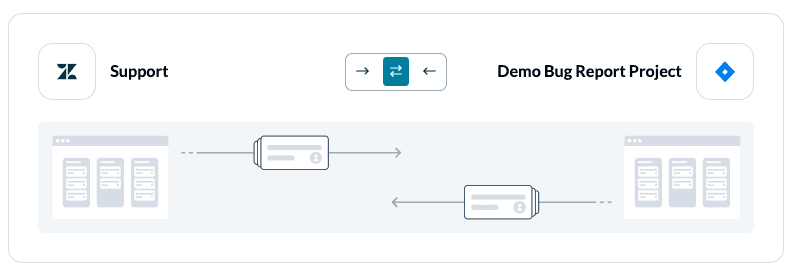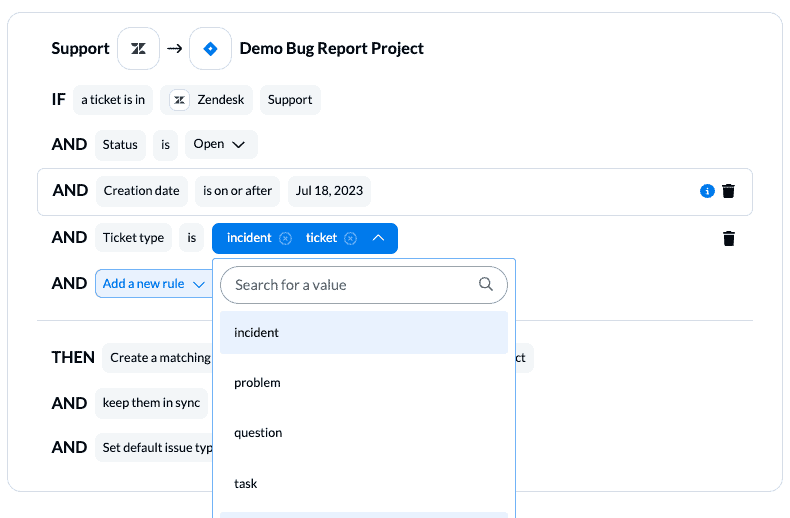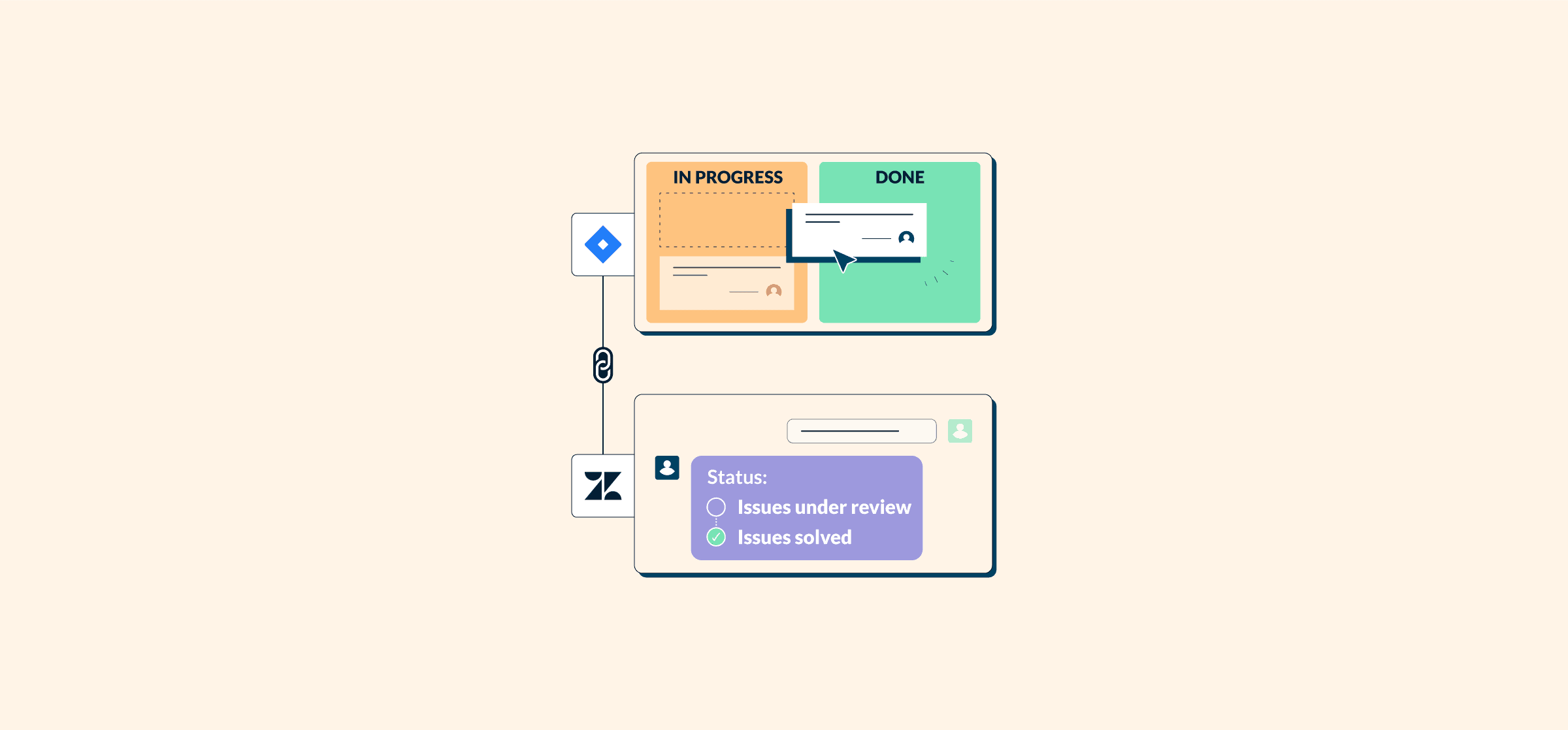A Zendesk Jira Integration: The Ultimate Project or Ticket Management Experience in 2025
If you run a SaaS company, you’ve almost certainly heard of both Zendesk and Jira. While Zendesk is one of the OG customer service platforms, Jira is a fan favorite for project management in agile DevOps teams. And if you’re using both, you get to benefit from customer support and DevOps teams that are always in sync and in problem-solving mode – sweet!
Of course, it’s not as simple as just creating accounts in each tool. To truly unlock the combined potential of these titans, you’ll want to integrate Jira and Zendesk. In this piece, we’ll talk about what a Zendesk-Jira integration looks like, why you need one, and how Unito makes it easy-peasy for your organization.
Is Zendesk an alternative to Jira?
You wouldn’t be the first to ask this question. Both are top-rated SaaS solutions that come with ticket management systems in the form of Zendesk for Service and Jira Service Management. They’re both also designed for efficient problem solving and teamwork. And many do consider using Zendesk as a Jira alternative, and vice versa.
That being said, if you’re asking: “Which is better, Zendesk or Jira?” there’s no good answer to that. Picking one boils down to what your core use case will be.
- Zendesk is primarily a customer support solution. It’s designed for teams that deal directly with customers, with each new case represented and tracked by a ticket.
- On the other hand, Jira is primarily an IT support solution. It’s an agile project management tool that lets DevOps teams (perhaps in ServiceNow or AzureDevOps) track software bugs with ease. An issue in Jira is equivalent to a ticket in Zendesk.
So the real question isn’t “which is better”. It’s: “How do I make the most of both Zendesk and Jira?”
The answer – you guessed it – by integrating them.

Why do you need a Zendesk-Jira integration?
In theory, your Zendesk team and your Jira team could work independently. Here’s what that might look like.
- A customer reaches out to the help desk with a problem.
- The customer support team creates a Zendesk ticket for that problem and looks into it.
- If it’s a software problem, customer support emails the DevOps team to take over.
- DevOps emails back with a solution, which customer support passes on to the customer.
Logistically, though, this can be a nightmare. Without automation or real-time updates, team members need to manually log every ticket and every corresponding issue, which means things move much more slowly. There’s also the risk of duplicate records or missing information if your teams are in silos.
On top of that, there’s no clear way to track what’s been resolved – one team has to call or email the other, which leads to more confusion, more disarray, and more potential for misunderstandings or clashes.
Some organizations address this by sticking to a single platform and having both teams collaborate on it. But like we said, it’s not about Zendesk VS Jira. Each works very differently from the other, and neither DevOps nor customer support is likely to appreciate having to learn the ropes on a whole new platform. Which means you often end up with more friction than you began with.
What a Zendesk-Jira integration looks like
As you can tell, keeping your Zendesk and Jira teams separate isn’t a great idea. What you want is a system that lets you exchange data between Jira issues and Zendesk tickets in real-time, keeping everyone on the same page and enabling faster resolution.
Here’s what that looks like:
- A Zendesk ticket comes in with a query that the customer support team decides is a job for the DevOps team.
- The customer support team adds a tag to the ticket that automatically creates an issue in Jira, alerting the DevOps team.
- Once the DevOps team solves the issue, they add a relevant tag to it that appears as a resolved notification on the corresponding ticket in Zendesk.
- The customer support team lets the customer know how to solve the problem as per the DevOps team’s recommendations.
In addition, each platform can share internal comments, tags, and updates to clarify points or notify the other platform of status changes.
Using Wrike? Here’s our guide to syncing Zendesk with Wrike.
How to integrate Zendesk and Jira with Unito
Follow along with this video or Unito’s step-by-step Zendesk Jira walkthrough.
Here’s how to set up a Zendesk Jira integration with Unito quickly:
- Sign up for Unito!
It’s free for 14 days and comes with unlimited changes so you can test it out to your heart’s content!
- Connect your tools
Connect Jira and Zendesk to Unito. Jira requires a couple of extra steps, but it won’t take more than a minute!

- Decide if you want Unito to create Zendesk tickets or Jira issues automatically. Or both!
Pick your source and destination tool. A two-way flow direction here sends work items in each direction.

- Set rules to filter specific Zendesk tickets or Jira issues
Here you can apply conditions for which Zendesk tickets and Jira issues to keep in sync with Unito. So if you only want to sync some work items by label or status, this is the place to do it.

- Pick which fields to map between Zendesk and Jira
Select auto-map for a pre-made template and adjust as needed. This is where you tell Unito which fields to link between Zendesk and Jira. The directional arrows here determine where automated changes occur based on activity in each tool.

Benefits of integrating Zendesk and Jira
With Unito’s Zendesk-Jira integration, problem solving becomes a whole lot easier. Here’s why.
Automatic data exchange
For every Zendesk ticket raised and tagged, a corresponding Jira issue is created. There’s no need to manually log or update anything on either platform.
Customizable data filtering
You can create rules to filter out what kinds of data get exchanged on Zendesk and Jira so that each team gets only the information they need, without unnecessary details.
Automatic status updates
The support team can check in on their Zendesk ticket status at any time through the integration app. There’s no need to keep calling DevOps or wait anxiously for updates.
Better collaboration
With a Zendesk-Jira integration, the customer support and DevOps teams each work on the platform they’re comfortable with while helping each other solve problems. If anyone has questions, they can just add a comment to the relevant Jira issue or Zendesk ticket – and anytime there’s an update, everyone gets to know.
Better service delivery
With real-time data exchange and smoother collaboration, each ticket/issue moves along the queue much more quickly. Faster processes = faster resolution = happier customers!
Best practices for implementing a Zendesk-Jira integration
As with any new system or process, a Zendesk-Jira integration will have its teething troubles. Here’s how to overcome them.
Have clear syncing rules
Work with your customer support and DevOps teams to set up clear rules on what data and filters can be shared between platforms. This is important – you don’t want to clutter the workflow with extras.
Provide necessary training
Your teams may not be leaving their original platforms, but they still need to know how the Zendesk-Jira integration tool works! Have a training period where both teams get to see what a Zendesk ticket looks like as a Jira issue (and vice versa) and how they can ask questions or add updates.
Keep monitoring and adapting
As the integration gets underway, keep an eye out for any bottlenecks and encourage each team to share feedback. You might find, for instance, that you need more fields than you expected – or that certain workflow steps can be trimmed.
Address any disputes promptly
While it’s important that both your teams retain autonomy, it’s equally important to step in if there are clashes. If customer support feels that DevOps is taking too long to address issues, or if DevOps feels that customer support is sending too many tickets over, have both teams present their sides and reach a mutual agreement. Because remember, the ultimate goal for everyone is still the same – giving the customer stellar service!
How to seamlessly sync Zendesk with Jira
In case you didn’t know, Zendesk comes with its own in-app support for Jira integration. So does Jira, for Zendesk. These native apps are great in their respective environments, but they have limitations when it comes to syncing.
What you need is a two-way Zendesk-Jira integration that’s easy to set up, is user-friendly for both your teams, and enables faster and smarter problem resolution.
And that’s exactly what Unito does! Automated two-way updates are just the beginning – you get to craft workflows tailored to your unique needs, with as many custom fields and subtasks as you want. The best part? You can get up and running in 12 minutes or less.
Save time and money, keep your teams happy, keep your customers happy – reach out to know more today!
Want to see how else you can use Unito with Zendesk? See how you can sync Zendesk to Slack for more streamlined ticket reporting.


